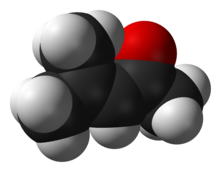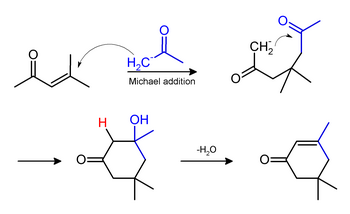Mesityl oxide

|
![]()
|

|
| Names
|
| Preferred IUPAC name
|
| Other names
Mesityl oxide
Isobutenyl methyl ketone
Methyl isobutenyl ketone
Isopropylidene acetone
|
| Identifiers
|
|
|
|
|
|
|
| ChEBI
|
|
| ChEMBL
|
|
| ChemSpider
|
|
| ECHA InfoCard
|
100.005.002 
|
| EC Number
|
|
|
|
|
| RTECS number
|
|
| UNII
|
|
| UN number
|
1229
|
|
|
|
InChI=1S/C6H10O/c1-5(2)4-6(3)7/h4H,1-3H3  Y YKey: SHOJXDKTYKFBRD-UHFFFAOYSA-N  Y YInChI=1/C6H10O/c1-5(2)4-6(3)7/h4H,1-3H3
|
|
|
| Properties
|
|
|
C6H10O
|
| Molar mass
|
98.145 g·mol−1
|
| Appearance
|
Oily, colorless to light-yellow liquid[1]
|
| Odor
|
peppermint- or honey-like[1]
|
| Density
|
0.858 g/cm3
|
| Melting point
|
−53 °C (−63 °F; 220 K)
|
| Boiling point
|
129.5 °C (265.1 °F; 402.6 K)
|
|
|
3% (20°C)[1]
|
| Solubility in other solvents
|
Soluble in most organic solvents
|
| Vapor pressure
|
9 mmHg (20°C)[1]
|
|
|
1.442
|
| Hazards
|
| Occupational safety and health (OHS/OSH):
|
Main hazards
|
flammable
|
| GHS labelling:
|
|
|
 
|
|
|
Warning
|
|
|
H226, H302, H312, H332
|
|
|
P210, P233, P240, P241, P242, P243, P261, P264, P270, P271, P280, P301+P312, P302+P352, P303+P361+P353, P304+P312, P304+P340, P312, P322, P330, P363, P370+P378, P403+P235, P501
|
| Flash point
|
31 °C; 87 °F; 304 K[1]
|
| Explosive limits
|
1.4–7.2%[1]
|
| Lethal dose or concentration (LD, LC):
|
|
|
1120 mg/kg (rat, oral)
1000 mg/kg (rabbit, oral)
710 mg/kg (mouse, oral)[2]
|
|
|
1000 mg/m3 (rat, 4 hr)
9000 mg/m3 (rat, 4 hr)
10,000 mg/m3 (mouse, 2 hr)
2000 mg/m3 (guinea pig, 7 hr)[2]
|
| NIOSH (US health exposure limits):
|
|
|
TWA 25 ppm (100 mg/m3)[1]
|
|
|
TWA 10 ppm (40 mg/m3)[1]
|
|
|
1400 ppm[1]
|
| Related compounds
|
Related compounds
|
diacetone alcohol
acetone,
benzylideneacetone
|
Except where otherwise noted, data are given for materials in their standard state (at 25 °C [77 °F], 100 kPa). |
Chemical compound
Mesityl oxide is a α,β-unsaturated ketone with the formula CH3C(O)CH=C(CH3)2. This compound is a colorless, volatile liquid with a honey-like odor.[3]
Synthesis
It is prepared by the aldol condensation of acetone to give diacetone alcohol, which readily dehydrates to give this compound.[4][5]

Phorone and isophorone may be formed under the same conditions. Isophorone originates via a Michael addition:

Phorone is formed by continued aldol condensation:

Uses
Mesityl oxide is used as a solvent and in the production of methyl isobutyl ketone by hydrogenation:[5]

Further hydrogenation gives 4-methyl-2-pentanol (methyl isobutyl carbinol).
Dimedone is another established use of mesityl oxide.
References
External links